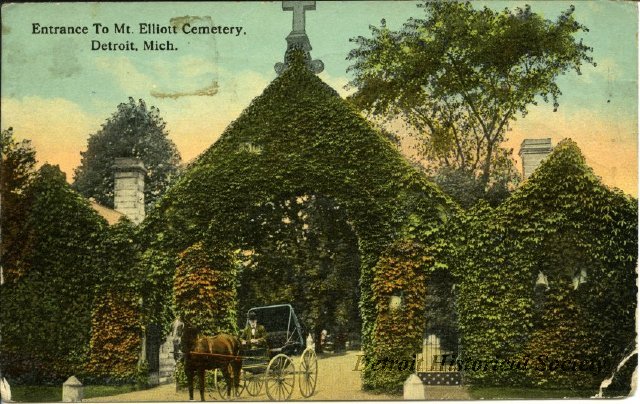Encyclopedia Of Detroit
Eastside Historic Cemetery District
The Eastside Historic Cemetery District contains the three oldest cemeteries remaining in the city of Detroit. The district is bounded by Elmwood Avenue, Mt. Elliott Avenue, Lafayette Street, and Waterloo Streets. The three cemeteries located within the district are Mount Elliott Cemetery, a Catholic Cemetery established in 1841, Elmwood Cemetery, a Protestant cemetery established in 1846, and the Lafayette Street Cemetery, a Jewish cemetery established in 1850.
Mount Elliott Cemetery is the oldest extant cemetery in Detroit and it covers 65 acres. The cemetery was named after Robert Elliott, a founding member of the committee that created the cemetery, who was buried there just twelve days after its establishment. The cemetery’s entrance is a stone gateway designed and built in 1882 by Walter Schweikart. Jerome Cavanagh, former mayor of Detroit, is also one of the notable Detroiters buried there.
Elmwood Cemetery is the largest of the three cemeteries at 86 acres. The cemetery is home to a Gothic revival chapel designed by Albert and Octavius Jordan and built in 1856. It also contains a Gothic-inspired gatehouse designed by Gordon Lloyd in 1870. The chapel was refurbished in the 1950s and is still in use today. The cemetery is also known for its monuments, including “Veiled Lady” by Randolph Rogers and “Flying Geese” by Marshall Fredericks. In addition to its well known buildings and monuments, many well known people are buried in Elmwood Cemetery. Twenty-nine Detroit mayors, including Coleman Young, six governors, including Lewis Cass, eleven senators, and many other notable people, including Bernhard Stroh, founder of the Stroh Brewery are buried there.
Lafayette Street Cemetery was established in 1850 by the Temple Beth El. The cemetery is Michigan’s oldest Jewish cemetery and it is also the smallest of the three cemeteries, covering only half an acre. In 1854, the first rabbi of Beth El, Samuel Marcus, was buried there. The Lafayette Street Cemetery was in active use until the 1950s.
At present day, the Eastside Historic Cemetery District signifies the last remaining unchanged topography in the city of Detroit. In 1982, the district was listed on the National Register of Historic Places.
RELATED ITEMS IN THE COLLECTION
View all items related to the Eastside Historic Cemetery District



